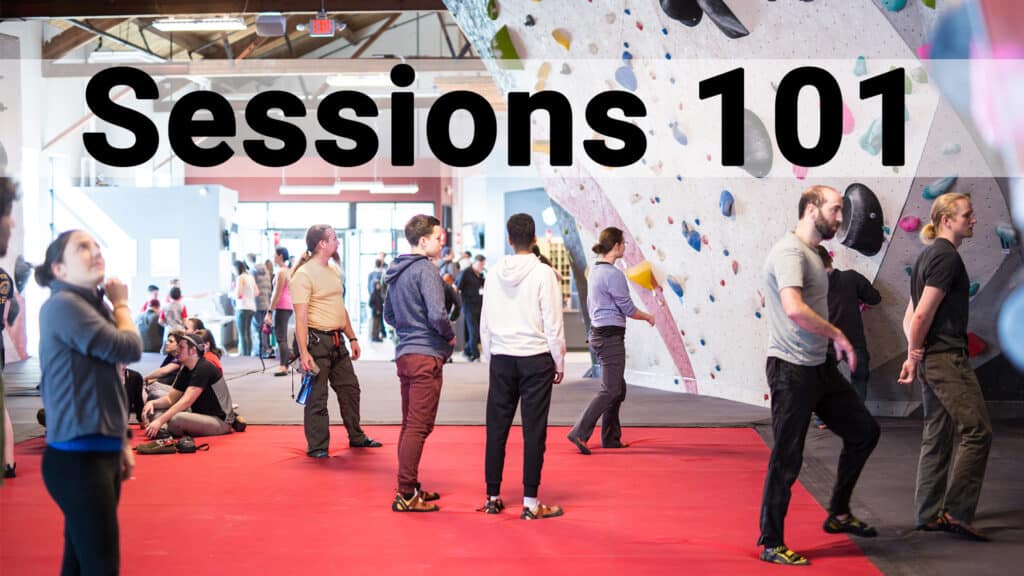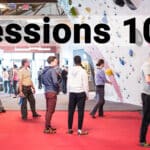Sessions 101

Do you find that all your climbing sessions look and feel the same? Looking to change up your climbing routine, wanting to embark on your progression journey, but don’t know where to begin? Do you go to the gym and meander through your session, not really knowing what you are working on? Maybe you are going from a reactive “just having fun” to thinking more proactively about your climbing? Don’t want to drop a lot of cash for private instruction and training? A good way to start is with different sessions. Focused sessions are a great way to “just have fun” and climb more while having a more focused approach.
Sessions be used strategically to avoid fatigue, work technique, gain endurance, and try hard, all while avoiding the dreaded “training regimen”. This approach keeps climbing at the forefront and allows you to “just climb more”.
What is a Session?
For this article, a session is going to be defined as a single time block of dedicated climbing but with a focus. If you are already climbing congratulations, you are doing sessions already, you might just be limiting yourself to a single type of session, which we call a “fun session” or a “volume session”.
What a session isn’t, is a super structured and rigid plan with too many specifics. Sessions go more off “feel” than keeping notes. A training plan would incorporate plans, and numbers and define progression accurately. We do want to loosely think about progression. A session is more focused on feel, and how we perceive we are exerting ourselves. This makes a session a lot less stressful and rigid to follow.
What is feel? How do our sessions feel, are we challenging ourselves? Are we trying hard? Where a training plan should have very detailed notes and plans (weight increasing on exercise, numbers increasing on grades etc.) a session is going to have just an overall evaluation. Did we try hard? Are we doing more? Are we moving better? Are we feeling healthier?
Below we have written out different session types, they can be applied to ropes and boulders. Switching between a couple is a good way to keep your psych high, and ensure we are staying fresh.
Session Types
- Fun– This session is what we all most likely started out doing. You go to the gym, and you follow your psych. You climb with friends and socialize. This session is great when you aren’t feeling good, and you can just “go with the flow”. These sessions are the least structured, you just do what you want. No rules, just want to have fun and do the cool climbs do it! These sessions can be restorative both mentally and physically. Just do what feels right and fun, just go and enjoy yourself!
- Mileage– This is the session we tend to gravitate towards when we start climbing more regularly and get more addicted to climbing. You just want to climb more and more, and as you get stronger you can. This session is about the total number of climbs you’ve done. Good goals to incorporate would be raising your total number of climbs in a session or take it a step further and also track your average V-Score. Average V-Score is the sum of your v-points divided by your total number of climbs. This can be a good indicator to track because your total number of climbs may drop as you climb harder, but your average v-score stays higher.
- Limit– This is a try hard session. Sending is not the goal. The goal is trying hard and failing. Yes, failure here is key. The goal is to work hard climbs you cannot do, this could mean spending half an hour on a single move, trying to understand all the small details that make that move possible. Think of it like the max weight you can lift, a PR Day. Your goal is to find “impossible for you” climbs and try to make them more possible. Through time, days, weeks, months, or years (yes years), these climbs should go from impossible to possible or possible feeling.
- Hard flash day/2nd go send– Find climbs on the edge of your flash ability. Try to do them perfectly and try really hard. If you are unable to flash them, welcome to part 2 of the session, the second and third go send try. If the flash doesn’t go as planned, try to send on your next two attempts. The goal here is we are trying hard, it’s a struggle to send, but we have a change at sending.
- Easy flash day/volume– The goal here is trying to send as many climbs as possible. First try and then move on, you can incorporate a second try sends, but the goal here is to get as much volume on climbs we haven’t done or tried before. These flashes should at our current flash level. If you flash V5 try stick around V4 and V5. The climbs should be challenging, but on the easier side of challenging where you think there is a solid chance of flashing.
- Send day/Performance Day– This is my favorite type of session next to the hard flash day. This session will incorporate climbs from the hard flash day that “got away” and climbs from your limit session that have slowly come together and now feel attainable. This is your chance to succeed and push your grades and performance. A good way to set goals for your performance session is to have several long and short term send goals. Long term send goals should come from your limit sessions, these climbs might take weeks or months to complete. While short term goals should come from your failed flash days. These are easier, but challenging climbs for you, that might take days or a weeks to do. With a well balanced list of short and long term goals, mixed in with regular limit and flash days, you should hopefully be sending on a regular basis, and building out a nice send pyramid. Sending is important physically and mentally, and should act as a gauge for your progression.
- Other- While we have just named a few sessions here, other sessions could be as specific or as vague as you’d like. You could have an ant style day. Feel really good on slopers but hate crimps, seek out all the crimpy routes in an effort to understand them better. Comp day session, do all the comp routes you can. Board day, climb on the Moon Board or Tension Board. Footwork day, focus on your footwork and give all your attention to feet and moving better.
Structuring your sessions
All climbing sessions should incorporate a warm up to get yourself feeling good and ready to perform. Limit and performance sessions might require more of a warm up so that you are ready to try hard. Don’t forget to warm up physically and mentally. Trying hard is a skill and needs to be taken seriously as grabbing a small hold or pulling hard.
Scheduling your session.
I like to first assess how I am feeling. If I am feeling “off” I might opt for an easier session. If I know a limit session or performance session is coming up, I might pair an easier session before it, so I know I am rested and feeling good to try hard. Pairing a fun or easy flash day is a great way to stay fresh, without fatiguing yourself for a try hard day.
Goals
An important aspect of the session structure is letting your goals guide you. A good blend of short and long term goals, that are attainable, is a must to keep psych high. I suggest having one broad overarching goal that suits your strengths. Could be a specific climb or grade, like climbing 5.10 or V5. Attaching a specific climb to the grade can also help you focus your sessions to reach that goal. Is that climb a crimpy overhanging boulder? Build your sessions around incorporating climbs similar to it. Non specific easier to attain goals are also good. Could be more climbs in your antistyle, harder sloper sends, harder flashes, or training goals (hang boarding with more weight or time, heavier weighted pull ups, or increasing flexibility). Having a running list with goals you can tick off is a great way to build psych and momentum to carry you through to your tougher goals.
The goal here is to progress while having fun! Do you have other types of sessions you do? Sessions success stories? Thoughts and opinions? Share your feedback with us!
Climbing is dangerous, it involves inherent and other risks and cannot be eliminated. The information presented here does not describe all of the risks associated with climbing and is not intended to replace or supersede expert instruction and training.
© 2024 Vertical Endeavors, Inc. All rights reserved. The contents of this article, photographs, and graphical representations are protected by U.S. and International copyright laws. Reproduction and distribution, in part or whole, without written permission from Vertical Endeavors are prohibited. The opinions and information contained in this article are for entertainment and informative purposes. They are those of the author and may not represent those of Vertical Endeavors, and do not necessarily reflect the ideas, ideologies, opinions, or points of view of the organization, affiliates, owners, stockholders, partners, suppliers, licensors, or staff. Under no circumstances shall Vertical Endeavors or any entity that is, has been, or will be affiliated be liable for any indirect, incidental, consequential, special, or exemplary damages arising out of or in connection with the information contained in this article.

